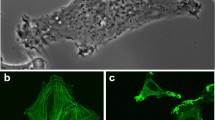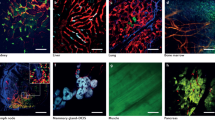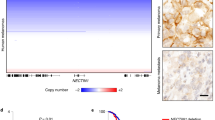Abstract
The acquisition of cell motility is an early step in melanoma metastasis. Here we use intravital imaging of signalling reporter cell-lines combined with genome-wide transcriptional analysis to define signalling pathways and genes associated with melanoma metastasis. Intravital imaging revealed heterogeneous cell behaviour in vivo: <10% of cells were motile and both singly moving cells and streams of cells were observed. Motile melanoma cells had increased Notch- and SRF-dependent transcription. Subsequent genome-wide analysis identified an overlapping set of genes associated with high Notch and SRF activity. We identified EZH2, a histone methyltransferase in the Polycomb repressive complex 2, as a regulator of these genes. Heterogeneity of EZH2 levels is observed in melanoma models, and co-ordinated upregulation of genes positively regulated by EZH2 is associated with melanoma metastasis. EZH2 was also identified as regulating the amelanotic phenotype of motile cells in vivo by suppressing expression of the P-glycoprotein Oca2. Analysis of patient samples confirmed an inverse relationship between EZH2 levels and pigment. EZH2 targeting with siRNA and chemical inhibition reduced invasion in mouse and human melanoma cell lines. The EZH2-regulated genes KIF2C and KIF22 are required for melanoma cell invasion and important for lung colonization. We propose that heterogeneity in EZH2 levels leads to heterogeneous expression of a cohort of genes associated with motile behaviour including KIF2C and KIF22. EZH2-dependent increased expression of these genes promotes melanoma cell motility and early steps in metastasis.
This is a preview of subscription content, access via your institution
Access options
Subscribe to this journal
Receive 50 print issues and online access
$259.00 per year
only $5.18 per issue
Buy this article
- Purchase on Springer Link
- Instant access to full article PDF
Prices may be subject to local taxes which are calculated during checkout







Similar content being viewed by others
References
Pinner S, Jordan P, Sharrock K, Bazley L, Collinson L, Marais R et al. Intravital imaging reveals transient changes in pigment production and Brn2 expression during metastatic melanoma dissemination. Cancer Res 2009; 69: 7969–7977.
Gupta PB, Kuperwasser C, Brunet JP, Ramaswamy S, Kuo WL, Gray JW et al. The melanocyte differentiation program predisposes to metastasis after neoplastic transformation. Nat Genet 2005; 37: 1047–1054.
Bailey CM, Morrison JA, Kulesa PM . Melanoma revives an embryonic migration program to promote plasticity and invasion. Pigment Cell Melanoma Res 2012; 25: 573–583.
Hoek KS, Eichhoff OM, Schlegel NC, Dobbeling U, Kobert N, Schaerer L et al. In vivo switching of human melanoma cells between proliferative and invasive states. Cancer Res 2008; 68: 650–656.
Hoek KS, Goding CR . Cancer stem cells versus phenotype-switching in melanoma. Pigment Cell Melanoma Res 2010; 23: 746–759.
Carreira S, Goodall J, Denat L, Rodriguez M, Nuciforo P, Hoek KS et al. Mitf regulation of Dia1 controls melanoma proliferation and invasiveness. Genes Dev 2006; 20: 3426–3439.
Goodall J, Carreira S, Denat L, Kobi D, Davidson I, Nuciforo P et al. Brn-2 represses microphthalmia-associated transcription factor expression and marks a distinct subpopulation of microphthalmia-associated transcription factor-negative melanoma cells. Cancer Res 2008; 68: 7788–7794.
Jarriault S, Brou C, Logeat F, Schroeter EH, Kopan R, Israel A . Signalling downstream of activated mammalian Notch. Nature 1995; 377: 355–358.
Balint K, Xiao M, Pinnix CC, Soma A, Veres I, Juhasz I et al. Activation of Notch1 signaling is required for beta-catenin-mediated human primary melanoma progression. J Clin Invest 2005; 115: 3166–3176.
Liu ZJ, Xiao M, Balint K, Smalley KS, Brafford P, Qiu R et al. Notch1 signaling promotes primary melanoma progression by activating mitogen-activated protein kinase/phosphatidylinositol 3-kinase-Akt pathways and up-regulating N-cadherin expression. Cancer Res 2006; 66: 4182–4190.
Pinnix CC, Lee JT, Liu ZJ, McDaid R, Balint K, Beverly LJ et al. Active Notch1 confers a transformed phenotype to primary human melanocytes. Cancer Res 2009; 69: 5312–5320.
Moriyama M, Osawa M, Mak SS, Ohtsuka T, Yamamoto N, Han H et al. Notch signaling via Hes1 transcription factor maintains survival of melanoblasts and melanocyte stem cells. J Cell Biol 2006; 173: 333–339.
Zabierowski SE, Baubet V, Himes B, Li L, Fukunaga-Kalabis M, Patel S et al. Direct reprogramming of melanocytes to neural crest stem-like cells by one defined factor. Stem Cells. 2011; 29: 1752–1762.
Olson EN, Nordheim A . Linking actin dynamics and gene transcription to drive cellular motile functions. Nat Rev Mol Cell Biol 2010; 11: 353–365.
Medjkane S, Perez-Sanchez C, Gaggioli C, Sahai E, Treisman R . Myocardin-related transcription factors and SRF are required for cytoskeletal dynamics and experimental metastasis. Nat Cell Biol 2009; 11: 257–268.
Clark EA, Golub TR, Lander ES, Hynes RO . Genomic analysis of metastasis reveals an essential role for RhoC. Nature 2000; 406: 532–535.
Kitzing TM, Wang Y, Pertz O, Copeland JW, Grosse R . Formin-like 2 drives amoeboid invasive cell motility downstream of RhoC. Oncogene 2010; 29: 2441–2448.
Morey L, Helin K . Polycomb group protein-mediated repression of transcription. Trend Biochem Sci 2010; 35: 323–332.
Ezhkova E, Pasolli HA, Parker JS, Stokes N, Su IH, Hannon G et al. Ezh2 orchestrates gene expression for the stepwise differentiation of tissue-specific stem cells. Cell 2009; 136: 1122–1135.
McHugh JB, Fullen DR, Ma L, Kleer CG, Su LD . Expression of polycomb group protein EZH2 in nevi and melanoma. J Cutaneous Pathol 2007; 34: 597–600.
Asangani IA, Harms PW, Dodson L, Pandhi M, Kunju LP, Maher CA et al. Genetic and epigenetic loss of microRNA-31 leads to feed-forward expression of EZH2 in melanoma. Oncotarget 2012; 3: 1011–1025.
Hou P, Liu D, Dong J, Xing M . The BRAF(V600E) causes widespread alterations in gene methylation in the genome of melanoma cells. Cell Cycle 2012; 11: 286–295.
Tiwari N, Tiwari VK, Waldmeier L, Balwierz PJ, Arnold P, Pachkov M et al. Sox4 is a master regulator of epithelial-mesenchymal transition by controlling ezh2 expression and epigenetic reprogramming. Cancer cell 2013; 23: 768–783.
Giampieri S, Manning C, Hooper S, Jones L, Hill CS, Sahai E . Localized and reversible TGFbeta signalling switches breast cancer cells from cohesive to single cell motility. Nat Cell Biol 2009; 11: 1287–1296.
Sanz-Moreno V, Gadea G, Ahn J, Paterson H, Marra P, Pinner S et al. Rac activation and inactivation control plasticity of tumor cell movement. Cell 2008; 135: 510–523.
Friedl P, Locker J, Sahai E, Segall JE . Classifying collective cancer cell invasion. Nat Cell Biol 2012; 14: 777–783.
Manning CS, Jenkins R, Hooper S, Gerhardt H, Marais R, Adams S et al. Intravital imaging reveals conversion between distinct tumor vascular morphologies and localized vascular response to Sunitinib. Intravital 2013; 2: 33–44.
Nuytten M, Beke L, Van Eynde A, Ceulemans H, Beullens M, Van Hummelen P et al. The transcriptional repressor NIPP1 is an essential player in EZH2-mediated gene silencing. Oncogene 2008; 27: 1449–1460.
Ren G, Baritaki S, Marathe H, Feng J, Park S, Beach S et al. Polycomb protein EZH2 regulates tumor invasion via the transcriptional repression of the metastasis suppressor RKIP in breast and prostate cancer. Cancer Res 2012; 72: 3091–3104.
Lee ST, Li Z, Wu Z, Aau M, Guan P, Karuturi RK et al. Context-specific regulation of NF-kappaB target gene expression by EZH2 in breast cancers. Mol Cell 2011; 43: 798–810.
McCabe MT, Ott HM, Ganji G, Korenchuk S, Thompson C, Van Aller GS et al. EZH2 inhibition as a therapeutic strategy for lymphoma with EZH2-activating mutations. Nature 2012; 492: 108–112.
Rosemblat S, Durham-Pierre D, Gardner JM, Nakatsu Y . Brilliant MH, Orlow SJ. Identification of a melanosomal membrane protein encoded by the pink-eyed dilution (type II oculocutaneous albinism) gene. Proc Natl Acad Sci USA 1994; 91: 12071–12075.
Chen K, Manga P, Orlow SJ . Pink-eyed dilution protein controls the processing of tyrosinase. Mol Biol Cell 2002; 13: 1953–1964.
Donnelly MP, Paschou P, Grigorenko E, Gurwitz D, Barta C, Lu RB et al. A global view of the OCA2-HERC2 region and pigmentation. Hum Genet 2012; 131: 683–696.
Sanz-Moreno V, Gaggioli C, Yeo M, Albrengues J, Wallberg F, Viros A et al. ROCK and JAK1 signaling cooperate to control actomyosin contractility in tumor cells and stroma. Cancer Cell 2011; 20: 229–245.
Gaggioli C, Hooper S, Hidalgo-Carcedo C, Grosse R, Marshall JF, Harrington K et al. Fibroblast-led collective invasion of carcinoma cells with differing roles for RhoGTPases in leading and following cells. Nat Cell Biol 2007; 9: 1392–1400.
Zhao XH, Laschinger C, Arora P, Szaszi K, Kapus A, McCulloch CA . Force activates smooth muscle alpha-actin promoter activity through the Rho signaling pathway. J Cell Sci 2007; 120: 1801–1809.
Andersson ER, Sandberg R, Lendahl U . Notch signaling: simplicity in design, versatility in function. Development 2011; 138: 3593–3612.
Sahlgren C, Gustafsson MV, Jin S, Poellinger L, Lendahl U . Notch signaling mediates hypoxia-induced tumor cell migration and invasion. Proc Natl Acad Sci USA 2008; 105: 6392–6397.
Goswami S, Wang W, Wyckoff JB, Condeelis JS . Breast cancer cells isolated by chemotaxis from primary tumors show increased survival and resistance to chemotherapy. Cancer Res 2004; 64: 7664–7667.
Ishikawa K, Kamohara Y, Tanaka F, Haraguchi N, Mimori K, Inoue H et al. Mitotic centromere-associated kinesin is a novel marker for prognosis and lymph node metastasis in colorectal cancer. Br J Cancer 2008; 98: 1824–1829.
Nakamura Y, Tanaka F, Haraguchi N, Mimori K, Matsumoto T, Inoue H et al. Clinicopathological and biological significance of mitotic centromere-associated kinesin overexpression in human gastric cancer. Br J Cancer 2007; 97: 543–549.
Sahai E, Wyckoff J, Philippar U, Segall JE, Gertler F, Condeelis J . Simultaneous imaging of GFP, CFP and collagen in tumors in vivo using multiphoton microscopy. BMC Biotechnol 2005; 5: 14.
Acknowledgements
We thank members of the Tumour Cell Biology laboratory for their discussion and comments. We thank Richard Treisman’s laboratory for reagents. We are indebted to the Experimental Histopathology laboratory, FACS laboratory and Biological Resources Unit at the London Research Institute and Rosamond Nuamah and Charles Mein at Barts and The London Genome Centre. We are extremely grateful for PhD sponsorship of CSM from The McGrath Charitable Trust via Cancer Research UK. This study was supported by Cancer Research UK.
Author Contributions
CSM and EAS designed the experiments and wrote the manuscript. CSM, SH and EAS performed the experiments.
Author information
Authors and Affiliations
Corresponding author
Ethics declarations
Competing interests
The authors declare no conflict of interest.
Additional information
Supplementary Information accompanies this paper on the Oncogene website
Supplementary information
Rights and permissions
About this article
Cite this article
Manning, C., Hooper, S. & Sahai, E. Intravital imaging of SRF and Notch signalling identifies a key role for EZH2 in invasive melanoma cells. Oncogene 34, 4320–4332 (2015). https://doi.org/10.1038/onc.2014.362
Received:
Revised:
Accepted:
Published:
Issue Date:
DOI: https://doi.org/10.1038/onc.2014.362
This article is cited by
-
UHRF1/UBE2L6/UBR4-mediated ubiquitination regulates EZH2 abundance and thereby melanocytic differentiation phenotypes in melanoma
Oncogene (2023)
-
Bridging live-cell imaging and next-generation cancer treatment
Nature Reviews Cancer (2023)
-
The roles of EZH2 in cancer and its inhibitors
Medical Oncology (2023)
-
TBX15/miR-152/KIF2C pathway regulates breast cancer doxorubicin resistance via promoting PKM2 ubiquitination
Cancer Cell International (2021)
-
A positive feedback loop between EZH2 and NOX4 regulates nucleus pulposus cell senescence in age-related intervertebral disc degeneration
Cell Division (2020)



